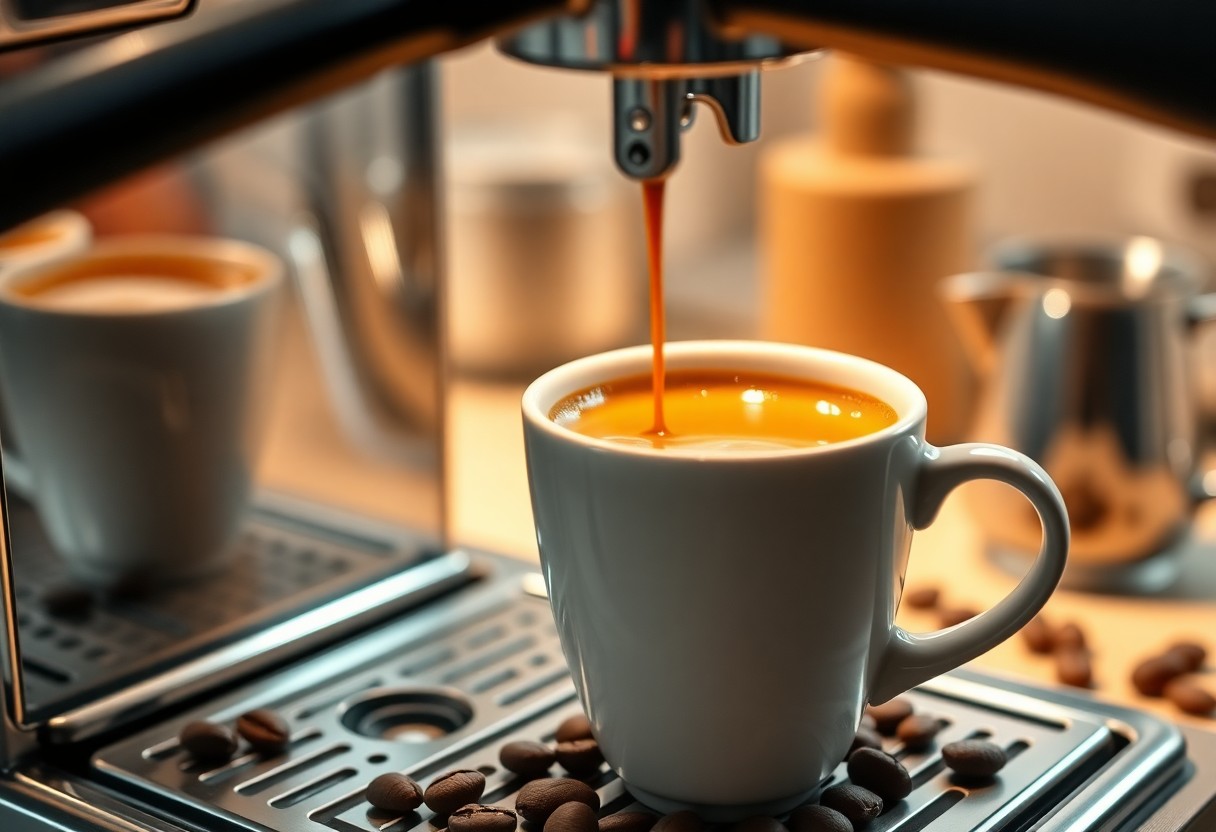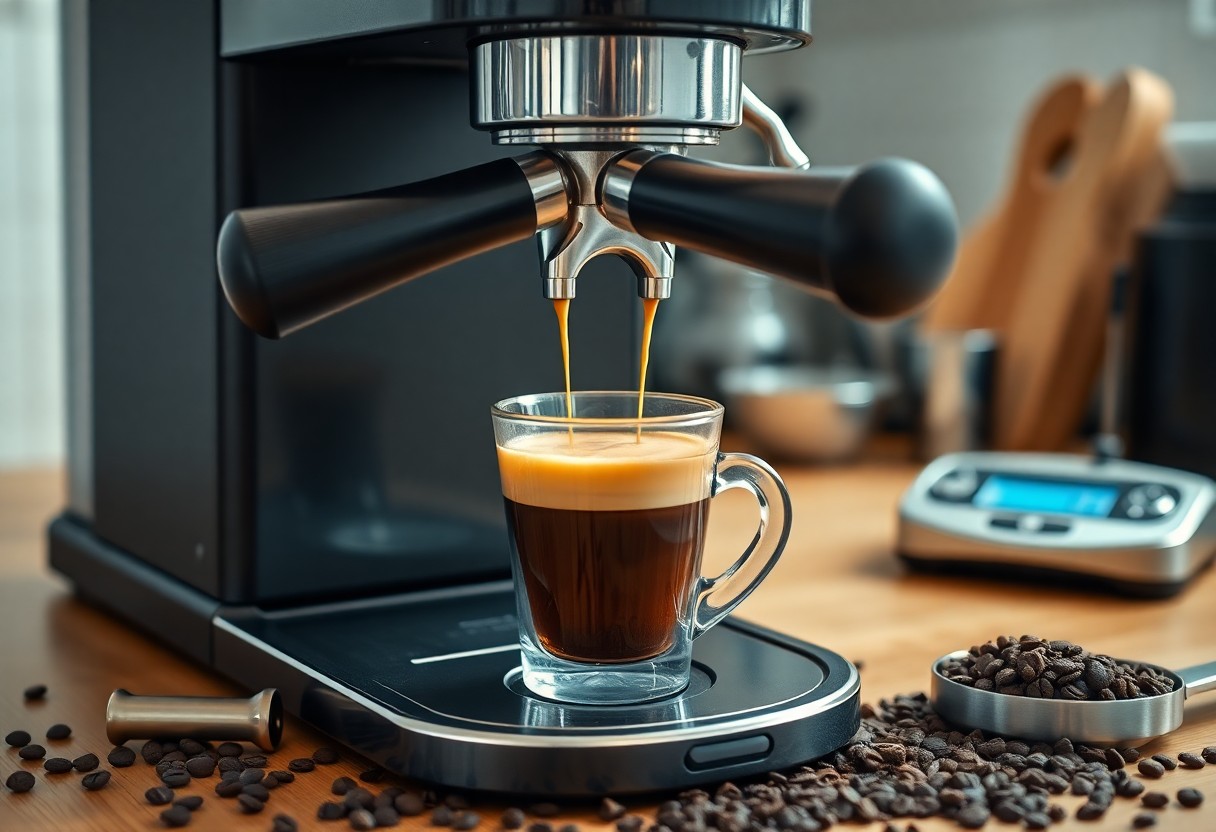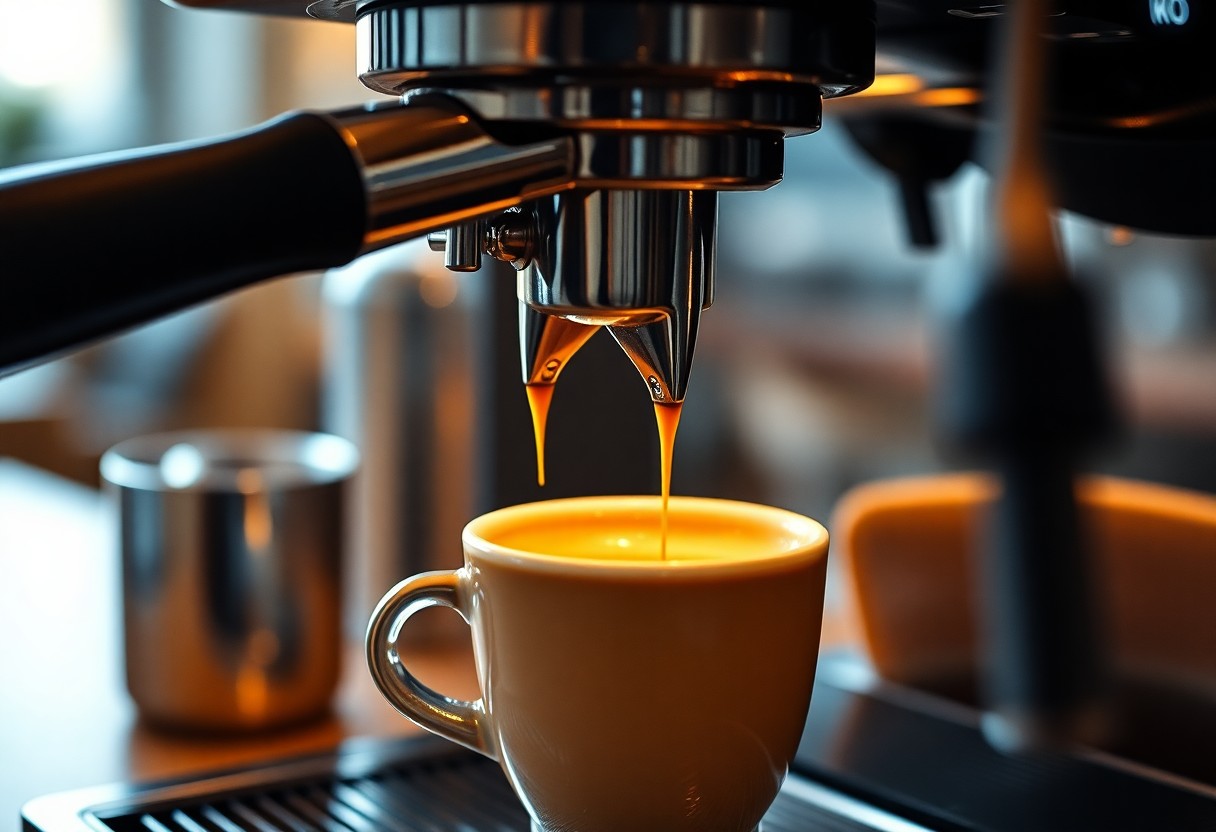You can achieve rich, velvety crema at home without breaking the bank on an espresso machine. With the right techniques and a few adjustments, you can bring the café experience to your kitchen. Understanding grind size, temperature, and pressure will enable you to unlock the potential of a budget espresso machine. In this guide, you’ll learn practical steps to elevate your espresso shot, impressing family and friends with a café-quality experience that’s both delicious and satisfying. Let’s explore the world of espresso and make your morning brew extraordinary!

Key Takeaways:
- Invest in a quality coffee grinder for consistent, fine grounds, which are crucial for achieving rich crema.
- Experiment with different coffee blends and roast levels to find the perfect flavor profile that compliments your espresso.
- Pay attention to brewing time and pressure; aim for about 25 to 30 seconds for optimal extraction to enhance crema development.
The Science of Crema: What Makes It Perfect?
Crema, that rich golden layer atop a well-pulled espresso, is a sign of a quality brew. Its perfect texture and color are a result of various factors working in harmony, including pressure, temperature, and the composition of the coffee grounds. When these elements align, the result is a velvety foam that enhances both aroma and flavor, creating an authentic café experience right in your kitchen.
The Role of Pressure in Espresso Extraction
Achieving that ideal crema hinges on the right pressure during extraction. Typically, espresso machines operate around 9 bars of pressure, which forces hot water through finely ground coffee. This pressure is important for emulsifying the oils and gases in the coffee, leading to the formation of microbubbles important for a stable crema layer. Inadequate pressure can yield a flat espresso with little to no crema, while overly high pressure can lead to bitterness.
The Importance of Fresh Beans and Grind Size
Using freshly roasted beans and the correct grind size is key in crafting a memorable espresso. Freshly roasted beans not only retain their natural oils but also contain volatile compounds that contribute to aroma and flavor. A grind size that is too coarse may lead to under-extraction, resulting in a weak crema, while a grind that is too fine can cause over-extraction, imparting bitterness and a dry texture. Striking the right balance through experimentation will ensure you pull shots that consistently yield satisfying crema.
Optimal freshness can translate to espresso magic. Beans should ideally be used within two to four weeks post-roasting for maximum flavor impact. Grinding just before brewing captures those fleeting flavors and aromas. A fine grind, usually about the texture of table salt, allows for faster extraction necessary for good crema formation, but adjustments might be needed based on your machine’s specifics. Finding that sweet spot may require fine-tuning, yet it guarantees your espresso experience is elevated each time you brew.

Budget Machines: Dispelling Myths and Misconceptions
Many coffee enthusiasts assume that you need a high-end espresso machine to achieve café-level crema. However, this perception often deters you from exploring budget-friendly options that can still deliver great results. By focusing on the right techniques and features in an affordable machine, you can unleash the potential of lower-cost models without sacrificing quality.
Overcoming Preconceptions About Low-Cost Models
Low-cost espresso machines are often dismissed as inferior, based on the belief that price directly correlates with performance. However, many budget models feature technology that enables efficient extraction, provided you fine-tune your technique. Choosing an economical machine doesn’t mean compromising on quality; it opens doors to discovering your barista skills without breaking the bank.
Key Features to Look for in an Affordable Espresso Machine
When searching for a budget espresso machine, several key features can help you achieve that sought-after crema. Look for machines that provide consistent pressure, good temperature stability, and ease of use. Pay attention to the following features:
- Pressure System: A machine with a minimum of 9 bars of pressure ensures proper extraction.
- Temperature Control: Temperature stability is key for optimal extraction, aim for machines with decent pre-heating abilities.
- Portafilter Quality: A solid portafilter helps in better water distribution over coffee grounds.
- Steam Wand: Look for a machine with a steam wand for milk frothing capabilities.
- Size and Design: Ensure the machine fits your kitchen space and suits your aesthetic preferences.
After assessing these features, you might be surprised at how many budget machines meet these criteria. Some models are designed to mimic professional setups but at a fraction of the cost. Additionally, investing in a good grinder can enhance the versatility of your brewing options.
Moving forward, the right affordable espresso machine can elevate your coffee game significantly. Exploring options in online reviews and comparing features can also uncover hidden gems among budget models. By understanding these fundamentals, you can successfully navigate the market and choose a machine that not only fits your budget but delivers a delightful cup.
- Ease of Use: Machines that are user-friendly make the process enjoyable.
- Maintenance Requirements: Models with easy cleaning mechanisms can save you time.
- Durability: Look for machines made from quality materials that will stand the test of time.
- Customer Support: Reliable customer service can be invaluable for troubleshooting and repairs.
- Warranty: A solid warranty can provide peace of mind for your investment.
After evaluating these aspects, you’ll be better equipped to select a budget espresso machine that aligns with your needs and preferences, opening up the world of at-home specialty coffee without overspending.
Essential Techniques for Maximizing Crema
Achieving a rich crema requires mastery of specific techniques that elevate your espresso experience. Focusing on correct tamping, water temperature, and brew timing will enhance the flavor and texture of your coffee. Optimizing each element will create that coveted velvety foam layer that café baristas produce effortlessly. Here’s how to get the most out of your budget espresso machine.
Mastering the Art of Tamping and Poking
How you tamp your coffee grounds directly influences crema quality. Apply consistent pressure while ensuring even distribution in the portafilter, aiming for about 30 pounds of pressure. A technique called “poking” can also help; gently poking the surface helps break up any air pockets, leading to a more uniform extraction. This combination delivers a denser and richer crema.
The Proper Water Temperature and Timing
Achieving the right water temperature is vital for optimal extraction. Ideal brewing temperatures hover between 195°F and 205°F. Brewing time should range from 20 to 30 seconds for a balanced extraction. If the temperature is too high, you risk scalding the coffee, losing flavor and crema; too low, and you won’t extract the necessary oils. Pay attention to your machine’s performance to finesse this crucial aspect.
Table: Key Factors for Water Temperature and Timing
| Aspect | Optimal Range |
|---|---|
| Water Temperature | 195°F – 205°F |
| Extraction Time | 20 – 30 seconds |
Regularly calibrating your machine’s temperature setting ensures you’re consistently brewing within that 195°F to 205°F range. Invest in a thermometer if your machine lacks this feature. Adjusting your grind size can also impact timing: finer grounds extract more slowly while coarser grounds result in quicker brew times. Keep experimenting until you dial in that perfect balance!
Table: Adjustments for Grind Size and Brew Time
| Grind Size | Brew Time Impact |
|---|---|
| Fine | Slower extraction; ideal for rich crema |
| Coarse | Faster extraction; may lead to a weak crema |
Tweaking Your Setup: Equipment You Already Have
With a few adjustments, your existing equipment can elevate your espresso making. Begin by ensuring your grinder uniformly delivers the correct grind size—aim for a fine consistency similar to granulated sugar. Calibration of your espresso machine is vital; experiment with different extraction times to find the sweet spot for your chosen beans. Incorporating a scale for precise dosing ensures that each shot maintains consistency, aiding in the formation of a thick, velvety crema. Regular maintenance of your equipment also plays a vital role in ensuring optimal performance and flavor extraction.
DIY Hacks for Better Espresso Extraction
You don’t need to invest in expensive equipment for improved espresso extraction. Simple DIY hacks can significantly influence your results. For example, create a makeshift puck screen using a stainless steel mesh to ensure even water distribution over the coffee grounds. Another approach is to adjust the tamping pressure; a consistent 30 pounds of pressure when tamping can significantly impact the extraction profile.
Using Alternatives: Manual Techniques for Enhanced Flavor
Manual techniques can enhance flavor profiles and contribute to a creamier espresso experience. Consider using a *Moka pot* or *AeroPress* as alternatives to your espresso machine. These methods allow you to control variables like water temperature and brew time, which can produce a rich, flavorful outcome. Moreover, manual brewing often provides the opportunity to experiment with steep times and grind variations, ultimately contributing to a unique espresso taste with a delightful crema.
Using alternatives not only diversifies your espresso-making routine but also allows you to explore flavors that might otherwise go unnoticed. The AeroPress, for instance, is renowned for its versatility, enabling you to play with infusion times and water temperatures to unlock various notes within your beans. The Moka pot, while less forgiving in terms of pressure, can achieve a different intensity that surprises many. These methods, combined with careful attention to grind size and freshly roasted beans, can yield espresso-like shots that boast impressive crema, even on a budget.
The Role of Milk: Elevating Your Espresso Experience
Milk not only adds creaminess and flavor to your espresso but also enhances its visual appeal. The right milk-to-espresso ratio can elevate your drink, providing a balance of rich coffee notes and milky sweetness. Steaming and frothing milk correctly transforms your ordinary espresso into café-quality beverages. Choosing the right type of milk—be it whole, skim, or alternative options like oat or almond—also influences the final taste and texture, allowing for a tailored experience to match your preferences.
Techniques for Frothing Milk to Complement Espresso
Frothing milk to perfection enhances the overall espresso experience. Use a steam wand or frother, keeping your milk jug at a slight angle and positioning the wand just below the surface of the milk. Introduce air by gradually lowering the jug, creating a whirlpool effect. The goal is to reach a velvety microfoam that will beautifully meld with the espresso. Practice different temperatures; milk around 150°F works well for foaming without scalding, allowing you to develop that luxurious, cafe-style texture.
Creative Espresso-based Beverages to Try
Explore a world of espresso-based drinks beyond the standard latte or cappuccino. Consider crafting a mocha by adding rich chocolate syrup and topping it with whipped cream, or experiment with a flat white, a concentrated shot of espresso topped with a thin layer of microfoam for a bold yet creamy sip. If you’re feeling adventurous, a unique twist like a dirty chai blends spiced chai tea with espresso, creating a delightful fusion of flavors. Each variation offers an opportunity to explore your palate and enjoy new espresso experiences.
Many delightful espresso-based beverages await your experimentation, allowing you to customize and create drinks that cater to your taste buds. For instance, the beloved affogato serves up a scoop of vanilla ice cream topped with a shot of hot espresso—perfect for a sweet treat that balances cooling and warming elements. You can also try incorporating syrups, like vanilla or caramel, to add depth to your drinks, or even topping your espresso with flavored whipped cream for an indulgent finish. The possibilities are endless, so don’t hesitate to get creative in your kitchen!
To wrap up
Summing up, achieving café-level crema with budget espresso machines is entirely possible through some key techniques. Focus on using fresh, high-quality coffee beans and ensure proper grind size for optimal extraction. Pay attention to water temperature and pressure during brewing, and invest time in mastering your machine’s settings. With practice and a little experimentation, you can enhance your espresso experience, creating rich and velvety crema that rivals your favorite café. Enjoy exploring the world of espresso-making and savoring delicious shots in the comfort of your home.
FAQ
Q: What is crema and why is it important for espresso?
A: Crema is the golden, frothy layer that forms on top of a freshly brewed espresso shot. It consists of emulsified oils and tiny bubbles of carbon dioxide, which are released from coffee grounds during the brewing process. Crema is important because it adds richness and sweetness to the espresso, enhances the aroma, and contributes to the overall visual appeal of the drink. A rich crema indicates a well-brewed espresso, signifying freshness and quality in your coffee preparation.
Q: Can budget espresso machines produce good crema?
A: Yes, budget espresso machines can produce good crema, although the results might vary depending on the machine and techniques used. Look for machines that provide adequate pressure (ideally 9 bars) and maintain stable temperatures. Additionally, investing in good quality coffee beans and properly grinding them will significantly improve the quality of crema. By understanding the nuances of brewing and making some adjustments, you can achieve café-level crema even with a budget espresso machine.
Q: What type of coffee beans should I use for the best crema?
A: For optimal crema, choose high-quality, freshly roasted coffee beans specifically intended for espresso. Espresso blends, often featuring a mix of Arabica and Robusta beans, can enhance crema due to Robusta’s higher crema-producing oils and proteins. Focus on beans that are medium to dark roasted, as they generally have better flavor and produce a more vibrant crema. Always grind your coffee just before brewing to preserve the necessary oils and aromas that contribute to the crema’s quality.
Q: How do I grind coffee properly for espresso to achieve the best crema?
A: Grinding coffee correctly is vital for producing quality crema. Use a burr grinder for consistent particle size, which significantly impacts extraction. For espresso, aim for a fine grind that resembles table salt. Adjust the grind size according to your machine’s performance—if the brew is too fast and weak, make the grind finer; if it’s too slow and bitter, grind coarser. Fine-tuning your grind will help achieve the pressure necessary for optimal crema development during extraction.
Q: What brewing techniques can enhance the quality of the crema from a budget espresso machine?
A: To enhance crema quality from a budget espresso machine, focus on several key brewing techniques: First, ensure your equipment is clean, as residual coffee oils can negatively impact flavor and crema. Use the right tamping technique—apply even pressure to create a compact puck that allows for even extraction. Monitor the brew time; a typical espresso shot should take about 25-30 seconds to extract. Finally, experiment with water temperature; the ideal range is between 190°F to 205°F (88°C to 96°C) for optimal extraction and crema production. By refining these techniques, you can significantly improve the crema quality from your budget machine.
